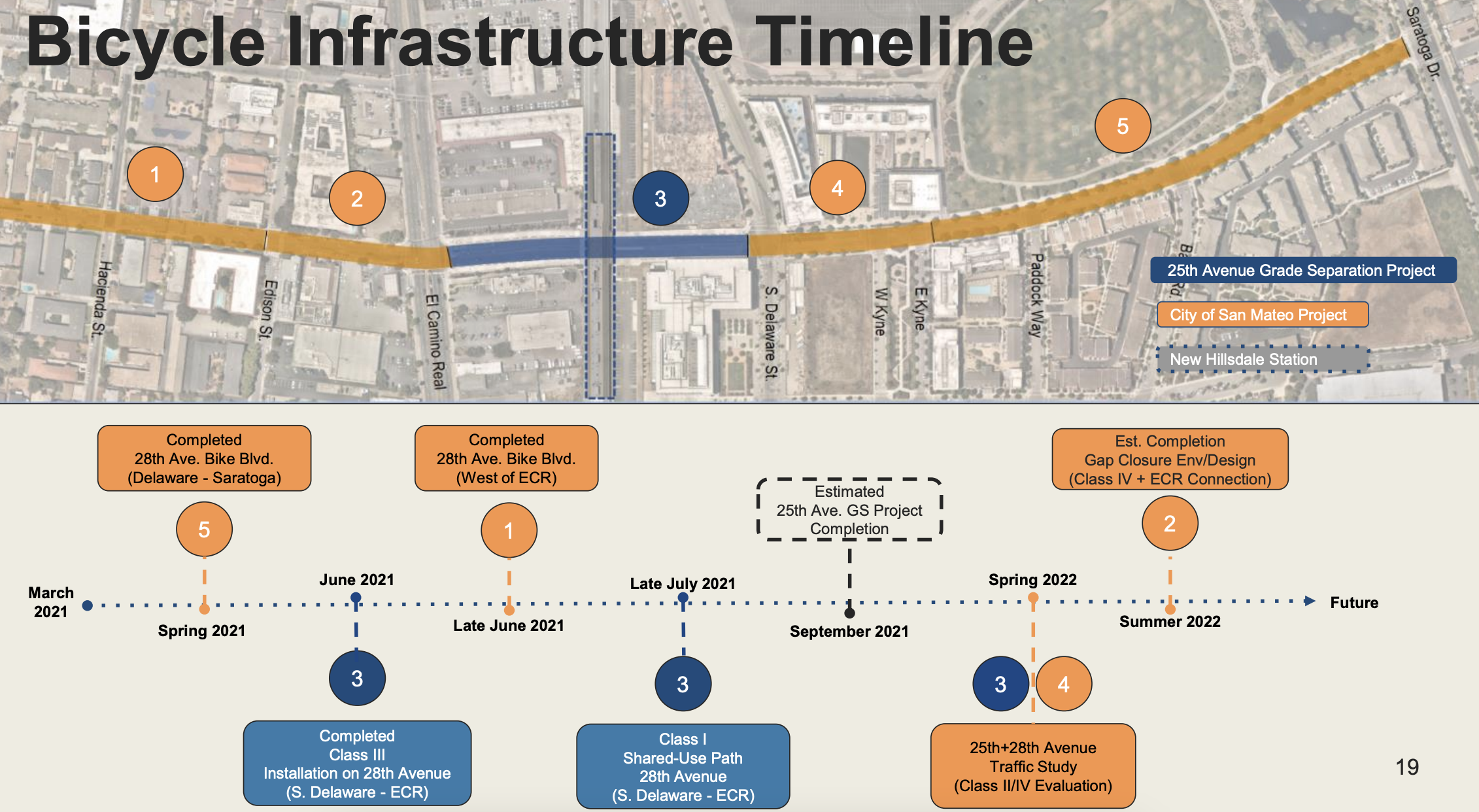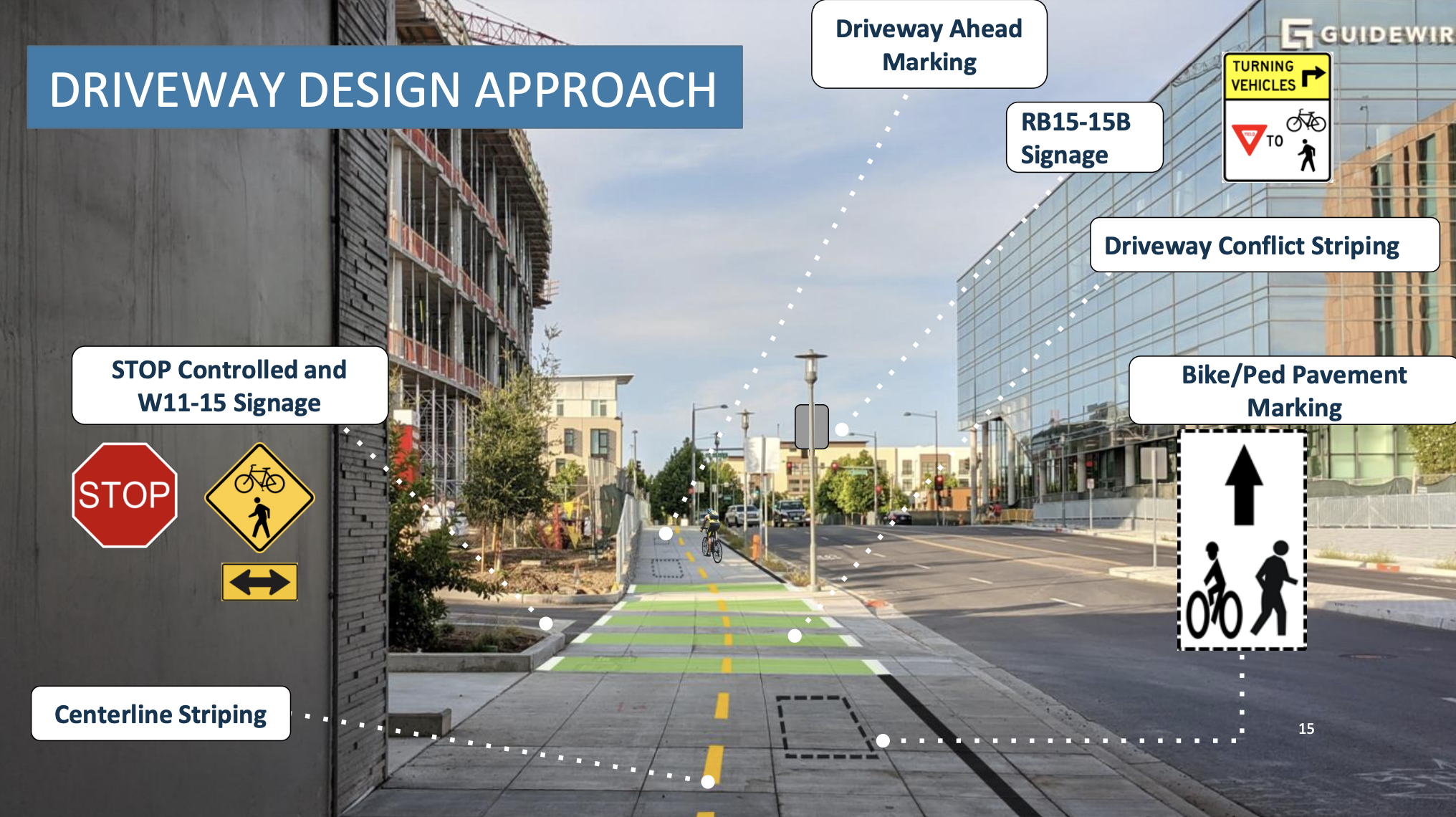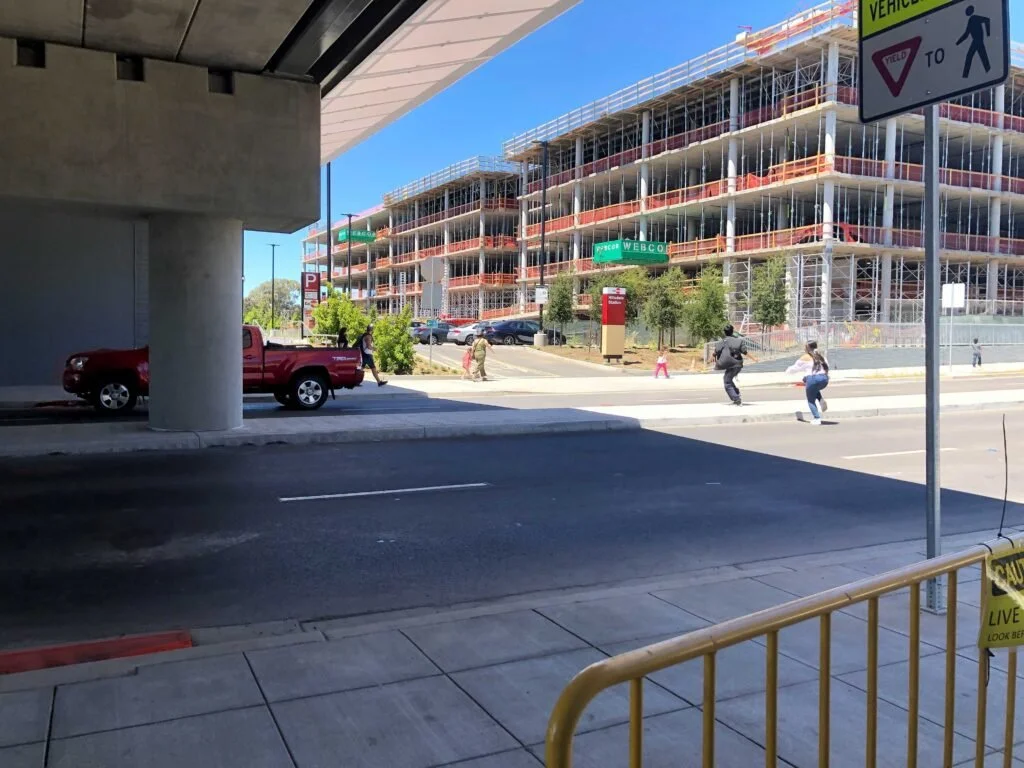28th Ave, Hillsdale Station: Mistakes and Lessons Learned
Summary: In the City of San Mateo, Caltrain recently completed the 28th Ave grade separation project. The design has four lanes of vehicle traffic for two blocks under the Caltrain tracks, though on either end of this section is only two lanes of traffic. The design includes a broad sidewalk/Class-I shared facility (for people walking and biking) on the north side. People biking are expected to maneuver two intersections to use this facility only for a very small stretch. The design inequitably favours people driving and invites higher speeds and more congestion in a location with high walking and biking activity. SVBC and other community members are requesting the city and Caltrain implement a road diet to build a Class IV facility for people biking. Caltrain and the City of San Mateo will be revisiting the design only after doing a traffic study in Spring of 2022. It is sad that a $205.9 million project, 4 years under construction, is unable to satisfy residents, especially people walking and biking and does nothing to combat car dependency in the face of climate change.This blog details out the issue, talks about the perspectives of different stakeholders and talks about mistakes that could be avoided in the future.
Stakeholders: Caltrain, City of San Mateo
Background: The 28th Ave Grade Separation project was envisioned first in 1999 and started construction in 2017. It mainly included raising the tracks and slightly lowering the road at E. 28th Avenue in San Mateo. The goal was to improve safety for both motorists and pedestrians, and reduce local traffic congestion in San Mateo. The station was opened in March 2021 and a new section of 28th Avenue opened between El Camino Real and S. Delaware Street.As the project neared completion, some residents highlighted issues with respect to visibility and safety for people biking on 28th. The agencies conducted a stakeholder meeting in November and promised to follow-up shortly. Unfortunately, we didn't meet with them until 7 months later, with all the issues still not addressed. The community members still feel unheard, and their voice being ignored has created distrust for city and agency staff. It is sad that a $205.9 million project, 4 years under construction, is unable to satisfy residents, especially people walking and bikingand does nothing to combat car dependency in the face of climate change.Issues with the current design:
Car-centric design: The current underpass design is a 4-lane road on 28th Avenue for approximately 2 blocks, even though 28th Avenue on either side of the underpass is a two-lane road. Many people walk and bike to Hillsdale station as well as across the Caltrain corridor, but the design inequitably favors people driving. It invites higher speeding and more congestion, making it dangerous for people walking across the roadway, and creates many conflict points for people biking as they navigate the underpass.
The lanes are 11’ and 12.5’ wide which invites higher speeds. The lanes could easily be cut down to 10’ to accommodate a bike lane at least on one side of the road.
Safety of bicyclists: The design (which is not yet implemented due to design errors) is to have people biking share one widened sidewalk/Class I facility on the northside of 28th Ave. with pedestrians for a short distance. This is concerning because people biking need to maneuver at two intersections to be able to use the Class I facility for a small stretch. Most people biking would rather continue on the same side of the road. The interim plan is that shared lane markings (sharrows) and signage has been added to 28th Ave. in both directions. However, SVBC does not feel that this provides a safe route for people biking.
No consistency in bike facilities: Proposed bike facilities for the 28th Ave. corridor includes all types of bike lanes ranging from Class I to Class IV. That would add tremendous confusion for those biking and also for those driving. This might lead to conflicts between the different roadway users.
Image: Bicycle infrastructure timeline as shared at the Virtual Community Meeting presentation held on June 30, 2021
Visibility issues at the North parking lot entrance - The pillars of the elevated Hillsdale station act as visibility barriers for those exiting the parking lot and the sidewalk/Class I facility users. Thanks to community members for pointing this issue out. The agency has now made various driveway improvements to increase bike/ped visibility (see below).
Image: New driveway improvements done by Caltrain to improve visibility at the parking lot entrance; as shared at the Virtual Community Meeting presentation held on June 30, 2021
Pedestrian Crossings: Currently, there are two places for pedestrians to cross 28th Avenue at street level – at El Camino Real and at Delaware Street. This means that anyone who would like to cross between the parking lots or station entrances from 28th Avenue must walk over 700’ or 0.2 mile. But people chose to create their own paths and prefer to just run across rather than taking this longer detour. (See image below).
Image: The design, though aimed at improving safety for all, ended up biasing toward vehicular traffic, leaving pedestrians to venture on their own.
Next steps:
Caltrain and the City of San Mateo: Conduct a traffic study in Spring of 2022 for feasibility of Class II or Class IV on 28th Avenue (Delaware -ECR).
SVBC thinks that waiting for another 10 months for a study which will determine if what the community wants can be done or not does not make sense. The agencies want to wait til “traffic returns to normal,” however, this is a new road. This passage for cars did not exist before this project, so this is a good time to implement changes that would make it easier for people walking and biking.
What the community proposes: Pilot high-quality, on-street protected bike lanes or buffered bike lanes by converting the curbside travel lanes to bike lanes. Conduct the traffic study to evaluate alternatives when the new railroad crossings are opened and traffic is back to “normal.” This will allow for immediate improvements that can be reversed if the need truly arises. City does not have to do a lengthy environmental review (which isn’t required for bike/ped projects under recent CEQA reform) to implement a quick-build pilot that doesn’t increase vehicle capacity. The city can pilot a road diet to make room for protected bicycle lanes. In the absence of viable alternatives for people riding bicycles, this can and should be implemented immediately. Read more here.
Learnings
For agencies: A street/roadway change, especially crossing the Caltrain tracks, is a complicated affair since it often involves multiple stakeholders and is very expensive. Also, street designs generally get revisited only once in several years. Hence, it is important that whenever any roadway changes are done, every agency takes care of the following things:
Is it a complete street design? - is the proposed design really benefiting ALL road users? If so, how?
Are the community needs being addressed?
Large projects like these take several years to complete. The existing conditions or needs may change in this period. Also, some issues may come to notice only when they are nearing completion or after completion. It is important to have flexibility in the design to be able to accommodate changes required to address these issues.
For community members: Design and planning of projects, especially big ones like these goes through multiple iterations and involves approval of multiple stakeholders. Making any major changes at a later point is not easy and oftentimes may not be possible. Residents need to be more aware and vigilant of what is happening in their surroundings. It is your responsibility to be more involved in these changes right from the planning and design stage so that you can make sure the city/agency is aware of your needs and takes that into consideration.




